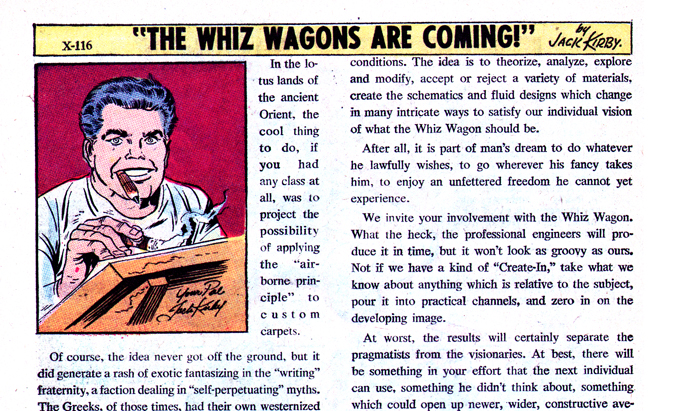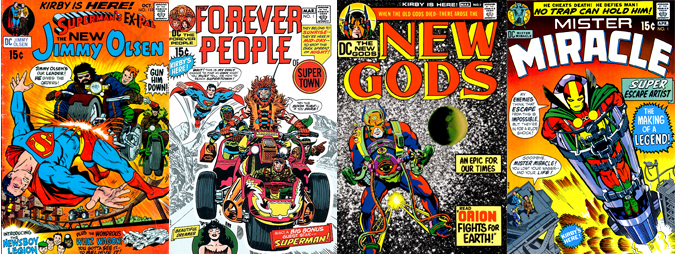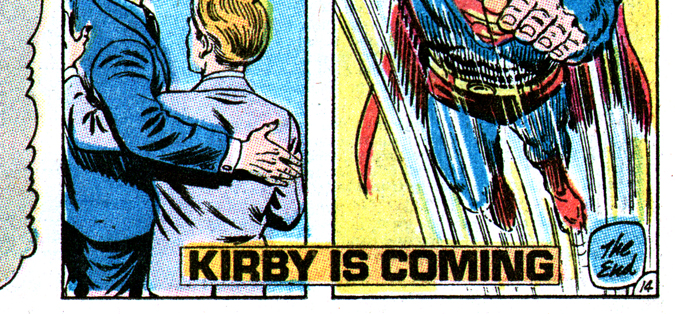Jacob Kurtzberg (the birth name of Jack “The King” Kirby) grew up in the rough ’n’ tumble streets of New York City’s Lower East Side, living a hard-scrabble childhood where kids survived by their wits and fists. The ghetto was rife with real-life gangsters and kid gangs, and (as seen in Jack’s superb autobiographical tale, “Street Code” [remastered in Streetwise, co-edited by yours truly and John Morrow, esteemed TJKC editor/publisher]) life was anything but idyllic. Perhaps the two most idolized local sons were, tellingly, Hollywood actor James “Public Enemy” Cagney and real-life hoodlum Charles “Lucky” Luciano (considered the “father” of organized crime). Early on, Jake was determined to flee the ghetto and to pursue life as an artist by any means necessary. His dream was one of escape.
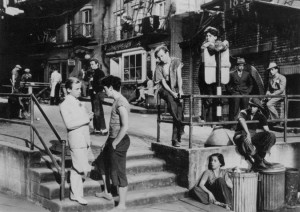 Kid gangs were most often distinguished by ethnicity, with an Italian crew on one block, a band of Irish punks on another, but certain areas were often mixed, where Jews mixed with Irish and Italian families. The common bond that cut across all types was living in poverty. In 1935, when Jake was in his late teens, the play Dead End by Sidney Kingsley premiered on Broadway and, within two years, the social commentary was adapted as a Hollywood movie. Dead End was a scathing indictment of East Side poverty and, of interest to us, it featured a group of teenage boys who would be immediately designated as “The Dead End Kids.” The gang appeared in seven Warner Brothers movies (including the Cagney vehicle Angels With Dirty Faces) and, remarkably, were spun off in three other film series, The East Side Kids (21 movies), Tough Little Guys (12 movies, three 12-chapter serials), and The Bowery Boys (an astounding 48 movies, called by Wikipedia, “the longest feature-film series in motion picture history,” a run that ended in 1958). Kid gangs were obviously a Hollywood sensation.
Kid gangs were most often distinguished by ethnicity, with an Italian crew on one block, a band of Irish punks on another, but certain areas were often mixed, where Jews mixed with Irish and Italian families. The common bond that cut across all types was living in poverty. In 1935, when Jake was in his late teens, the play Dead End by Sidney Kingsley premiered on Broadway and, within two years, the social commentary was adapted as a Hollywood movie. Dead End was a scathing indictment of East Side poverty and, of interest to us, it featured a group of teenage boys who would be immediately designated as “The Dead End Kids.” The gang appeared in seven Warner Brothers movies (including the Cagney vehicle Angels With Dirty Faces) and, remarkably, were spun off in three other film series, The East Side Kids (21 movies), Tough Little Guys (12 movies, three 12-chapter serials), and The Bowery Boys (an astounding 48 movies, called by Wikipedia, “the longest feature-film series in motion picture history,” a run that ended in 1958). Kid gangs were obviously a Hollywood sensation.
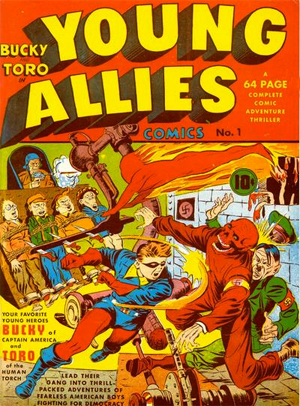 Leave it to Simon & Kirby to adapt the movie genre to the medium as, fresh from creating Captain America, the renowned team originated the first kid gang in comics, The Young Allies, a group which included a pugnacious streetfighter, a genius boy inventor, a chubby boy, a token (and reprehensible racial stereotype) black kid, and two super-hero sidekicks, Cap’s Bucky Barnes and the Human Torch’s Toro. The first issue of their same-named title [cover date Summer 1941] was an immediate hit and S&K had another notch on their creative belt. Naturally, upon their move to National (DC) Comics, they would immediately establish two new kid gangs, The Boy Commandos and The Newsboy Legion.
Leave it to Simon & Kirby to adapt the movie genre to the medium as, fresh from creating Captain America, the renowned team originated the first kid gang in comics, The Young Allies, a group which included a pugnacious streetfighter, a genius boy inventor, a chubby boy, a token (and reprehensible racial stereotype) black kid, and two super-hero sidekicks, Cap’s Bucky Barnes and the Human Torch’s Toro. The first issue of their same-named title [cover date Summer 1941] was an immediate hit and S&K had another notch on their creative belt. Naturally, upon their move to National (DC) Comics, they would immediately establish two new kid gangs, The Boy Commandos and The Newsboy Legion.
 The original Newsboy Legion first appeared in Star Spangled Comics #7 [cover date Apr. ’42] and their turf was Metropolis’s “Suicide Slum,” the same beat as young police officer Jim Harper, a do-gooder determined to improve the lives of the ghetto kids. The gang was a somewhat stereotypical bunch, mostly derived from Hollywood clichés: Scrapper, pretty much the crew’s leader, was the back-alley brawler, complete with prerequisite Brooklyn accent; Tommy, the nondescript good-looking, level-headed All-American teenager; Big Words, the bespectacled genius with overblown vocabulary; and Gabby, little tough guy with endless big talk. The lads, each one an orphan, hawked newspapers for a living and, of course, were embroiled in an endless string of crime-fighting adventures, told with the indomitable S&K gusto and verve. (We’ll leave a description of their illustrious co-star, The Guardian, and that vigilante’s relationship with rookie cop Harper, for the appropriate future entry.)
The original Newsboy Legion first appeared in Star Spangled Comics #7 [cover date Apr. ’42] and their turf was Metropolis’s “Suicide Slum,” the same beat as young police officer Jim Harper, a do-gooder determined to improve the lives of the ghetto kids. The gang was a somewhat stereotypical bunch, mostly derived from Hollywood clichés: Scrapper, pretty much the crew’s leader, was the back-alley brawler, complete with prerequisite Brooklyn accent; Tommy, the nondescript good-looking, level-headed All-American teenager; Big Words, the bespectacled genius with overblown vocabulary; and Gabby, little tough guy with endless big talk. The lads, each one an orphan, hawked newspapers for a living and, of course, were embroiled in an endless string of crime-fighting adventures, told with the indomitable S&K gusto and verve. (We’ll leave a description of their illustrious co-star, The Guardian, and that vigilante’s relationship with rookie cop Harper, for the appropriate future entry.)
The original Newsboy Legion would sell their last edition in 1947 [SSC #64, Jan.] and be all but forgotten until…
Perhaps Jack recalled the ’40s kid gang had lived in the same city as Superman — that metropolis called, umm, Metropolis — when planning his run on Superman’s Pal, Jimmy Olsen (reportedly one of DC’s lowest-selling titles at that time), with the intention to (of course) dramatically reverse the title’s fortunes. [VERY important to note, as Mike Hill notes in a reply, whether low-selling or not, as Mark Evanier points out in the JK4WO v.1 Afterword, Jack’s motivation for choosing JO was because there was no regular creative team assigned to the title and the King was loathe to push anyone out of a regular gig.] (It is difficult, sometimes, to imagine Jack planning anything as he seemed to approach the drawing table and spontaneously unleash his incredible imagination onto Bristol board, just allowing the epic to flow from his pencil unrestrained… like his characters, taking the adventure as it comes.) Assuredly he had affection for the group as he featured them as permanent co-stars in his debut effort at DC in 1970… well, not “them” exactly:
I guess the “introducing” blurb on JO #133’s cover was technically correct (though I’m still wary), as this ’70s version of the Newsboy Legion actually was comprised of (excepting one new addition) the sons of the original group, but they looked and acted precisely like their namesakes (albeit with “junior” attached to each name). The new member? Well, one might dismiss “Flipper Dipper” (or is it “Flippa Dippa”?) as a token black character but, whatever, the youthful frogman was a typically wonky Kirby concept: delightfully idiosyncratic and not without charm. When Jack got weird, he did it like he did everything else: He got weird in a big way!
(Mark Evanier and Steve Sherman’s text page, “The Newsboy Legion Returns” (JO #141) says there was a change made between Golden-Age character and Bronze-Age counterpart: “Gabby [Jr.]’s face has been slightly altered so that he no longer resembles a youthful version of President [Richard M.] Nixon, who had not yet entered public life when [the original] Gabby was designed.”)
The “new” Newsboy Legion are out to make news themselves, as they enlist Jimmy Olsen’s help to explore the “Wild Area,” to fly into a danger zone in the Big Words-designed “Whiz Wagon” [see Day One post]. Join us tomorrow as we focus on J.O.’s duplicitous new employer, Morgan Edge and his Galaxy Broadcast System! It’ll be, as James puts it, “Garooveee!”





